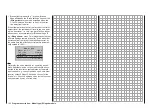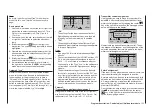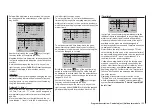
113
Program description - Servo adjustment
Column 4, “– trv +”
S1
S2
S3
Rev cent
+
trv
0%
0%
0%
100% 100%
100% 100%
100% 100%
0%
0%
100% 100%
100% 100%
S4
S5
This column is used to set servo travel symmetrically
or asymmetrically for each side. The setting range is
0 … 150 % of normal servo travel. The values set are
based on the settings that have been made for the
“midpoint” column.
To create a symmetric travel path, i. e. control-side
independent travel, the respective control (stick, pro-
portional control or switch) is to be put into a position
which covers travel to both sides of the marked frame.
Note:
It may be necessary to first assign a control attached
to one of the control channels 5 … 8 or 5 … 12. If
necessary, this is to be done in the »Control adjust«
menu, see page 118 or 122.
To set asymmetric travel, the respective control (stick,
proportional control or switch) is to be moved to the
side on which the marked frame only includes the
value to be changed.
The value setting is activated with a brief tap on the
center
SET
key of the right four-way button. The value
field is shown highlighted. Values can be changed
with the selection keys of the right four-way button.
Complete the entry with a tap on the center
SET
key
of the right four-way button.
A simultaneous tap on the
or
keys of the
right four-way button (CLEAR) will reset the changed
parameter displayed in inverse video back to “100 %”.
Important:
In contrast to settings made with the »Control
adjust« menu, all settings made in this menu af-
fect exclusively the respective servo, independent of
how the control signal for this servo is produced, i. e.
directly by a stick or by way of any mixer functions.
The adjacent figure shows
and example of a side-
dependent servo setting,
-50 % and +150 %.
Transmitter control travel
Ser
vo tr
av
el
Column 5 “– lim +”
The “– lim +” column is reached by moving the marker
frame, with the
selection keys of the left or right
four-ay button, to the right beyond the “– ”
column:
S1
S2
S3
Rev cent
+
lim
0%
0%
0%
150% 150%
150% 150%
150% 150%
0%
0%
150% 150%
150% 150%
S4
S5
To create a symmetric limit, i. e. control-side inde-
pendent limit, the respective control (stick, propor-
tional control or switch) is to be put into a position
such that the marker frame covers both sides of the
travel setting.
To set asymmetric travel, the respective control (stick,
proportional control or switch) is to be moved to the
side where it is to be set such that the marker frame
only includes the value to be changed.
Note:
You may first need to assign a transmitter control to a
servo connected to one of the control channels 5 …
8 or 5 … 12 in the »Control adjust« menu; see the
sections starting on pages 118 and 122.
A simultaneous tap on the
or
keys of the
right four-way button (CLEAR) will reset the entry
field value displayed in inverse video back to “0 %”.
Example:
A servo is controlled separately by two controls over
a mixer and but, for model-specific reasons, must
only be operated over a servo travel path of 100 %
because, for example, the rudder would mechanically
collide with the elevator if moved more than 100 %.
As long as only one control is used at a time, this is
no problem. But this does become a problem when
the signals are summed by the simultaneous use of
both controls (e. g. aileron and rudder) to total travel
in excess of 100 %. The linkage and servos could be
strained excessively …
To prevent this, the travel should certainly be limited
by way of an individual travel limit. In the case of the
rudder used in the example, this would be a value
slightly less than 100 % – because it is assumed the
rudder would collide at 100 %.
Summary of Contents for HoTT MC-16 Series
Page 1: ...Programming Manual mc 16 mc 20 HoTT 1 en mc 16 mc 20...
Page 27: ...27 For your notes...
Page 53: ...53 For your notes...
Page 61: ...61 For your notes...
Page 65: ...65 For your notes...
Page 71: ...71 For your notes...
Page 103: ...103 For your notes...
Page 107: ...107 For your notes...
Page 111: ...111 For your notes...
Page 155: ...155 For your notes...
Page 165: ...165 For your notes...
Page 201: ...201 For your notes...
Page 229: ...229 For your notes...
Page 231: ...231 For your notes...
Page 261: ...261 For your notes...
Page 265: ...265 For your notes...
Page 301: ...301 For your notes...
Page 327: ...327 For your notes...
Page 328: ...328 For your notes...
















































